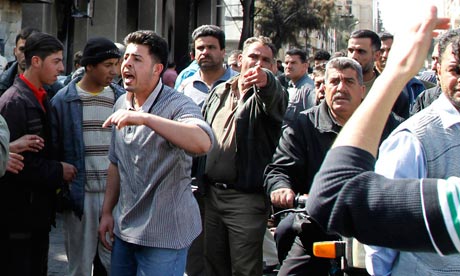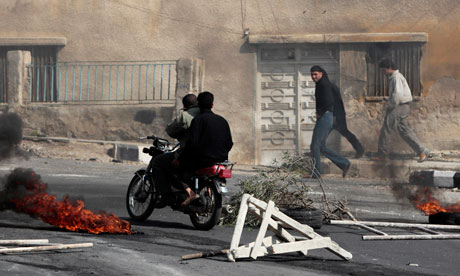Learn from professional Chef Karam and bake your own macarons today! #taylors #milkadeal
As revolt spreads through the Arab world, Libyan President Moammar Kadafi and Yemeni President Ali Abdullah Saleh take brutal steps to retain power.

Anti-government protesters flee as government backers repel their attack during clashes in Sanaa, Yemen. (Khaled Abdullah / Reuters / February 19, 2011)
Reporting from Cairo and Sana, Yemen —
The unrest convulsing the region has swept through Libya and Yemen, where demonstrators have grown fearless against the tear gas and bullets of entrenched police states. But even if the scenario is similar to the narrative played out in the overthrow of Egyptian President Hosni Mubarak, it is far from certain whether demonstrations can dislodge Libyan President Moammar Kadafi and Yemeni President Ali Abdullah Saleh.
Unlike Egypt, Libya and Yemen are tribal nations, and the two leaders have skillfully manipulated clan loyalties for decades.
With his eccentric, often inscrutable personality, Kadafi has ruled Libya, one of the world's largest oil producers, for 41 years through a mix of repression, patronage and shrewd tribal alliances. Saleh, who once described ruling Yemen as "dancing on the heads of snakes," has stayed in power for 32 years in much the same manner.
The heart of the revolt in Libya is in the eastern city of Benghazi, where dozens of people have died in recent days and tens of thousands of protesters have taken control of many neighborhoods. The army moved to crush dissent Friday, but by Saturday afternoon one witness said soldiers had abandoned two tanks in front of the courthouse and security forces had fallen back to bases.
"Kadafi is not in control of Benghazi," said the son of a former diplomat and military officer who asked not to be named. "By tomorrow, the city will belong to the people. There are no police here. But we've been isolated and shut off. The Internet is down. Cellphones are not working properly. Ten people were killed last night and we carried their coffins through town and buried them."
The tenor changed dramatically by Saturday evening, when reports emerged that security forces, including snipers, had opened fire on protesters and mourners. A doctor told the Al Jazeera network that he had glimpsed dozens of corpses at the city's hospital, which was on the brink of running out of blood for transfusions to treat the wounded.
"I have seen it on my own eyes: At least 70 bodies at the hospital," Wuwufaq al-Zuwail told the network. He said security forces had blocked ambulances from reaching the injured on the protest lines.
It was impossible to independently verify what has been unfolding in Benghazi, the country's second-largest city, which has been cut off to foreign media. The eastern region has long been marginalized by Kadafi, and anger has been growing over failed economic reforms, especially for the jobless young. There is also lingering hostility over the 1996 deaths of hundreds of inmates from the east killed in a massacre at Abu Salim prison in Tripoli.
"Libya is more like a black hole. It's very hard to see inside at all," said Joe Stork, deputy director for North Africa and the Middle East for Human Rights Watch. "Libya's police have in the past shown zero tolerance for any dissent. Especially public dissent. People have been locked up for years for organizing even small protests. What's new here is that large numbers of people are still coming out."
The Libyan protests are not the "beginning of a revolution," said Mustafa Labbad, head of Al Sharq Center for Political Studies in Cairo. "Libya is a tribal country and what happens in a certain area isn't necessarily accepted by or adopted by other tribes.... We've got all the protests in the east where the poorest of Libyans live and resent Kadafi the most. However, you need much more than just one part of a country to revolt," he said.
But U.S. diplomatic cables released recently by WikiLeaks reveal growing internal discontent with Kadafi.
"Static state salaries and inflation, particularly with respect to prices for food and key staples, have hit ordinary Libyans hard in the last two years," states a 2009 U.S. diplomatic cable. "Conspicuous consumption by regime elites, has not sat well with the silent majority.... The fact that many young men are forced by lack of means to delay marriage is another pressing economic issue in a conservative society in which marriage is a key social anchor."
In Yemen's southern coastal city of Aden, police in recent days relinquished parts of the town to protesters. It was uncertain whether security forces gained control Saturday after mobs attacked and burned police stations during the nation's ninth consecutive day of demonstrations.
Two protesters were killed and dozens injured when gunmen shot into the crowd from nearby rooftops and from a passing vehicle, according to local reports. Protesters in Aden said the gunmen were government security officers. Government officials denied the claim.
The rising violence points to years of frustration in Yemen — the Arab world's poorest country — and to Saleh's strained relations with tribal leaders. Saleh is confronting a secessionist movement in the south and a network of Al Qaeda militants on tribal lands beyond the capital, Sana. He recently attempted to buy off tribal leaders with cars and cash, according to local media.
"Politicians have always played the tribes card, and they will now that there are threats from the south and from the protesters," said Ali Saif Hassan, director of Yemen's Political Development Forum. "The tribes are a powerful force, and their loyalty will certainly be used to blackmail Saleh."
The danger the president faces was evident Saturday afternoon when a small band of pro-government supporters dressed in traditional clothing fired Kalashnikov rifles into a crowd of more than a thousand protesters gathered in front of Sana University. Protesters said the gunmen were security officers acting on orders from the government. Government officials denied any involvement in the shootings.
"I ask you, if my government is democratic, why am I afraid to go out on the street? Why am I afraid my government will put bullets in me?" said Kamal Daifalah, a doctor and an anti-government protester in Sana, who gave his great-grandfather's name for fear of reprisals from police. "This is not democracy. This is state terrorism."
Another anti-government protester, Farooq Abdulmalik, said he was willing to die for his freedom. "To live without freedom is another form of death," the 22-year-old student said. "We are not afraid."
jeffrey.fleishman@latimes.com




























